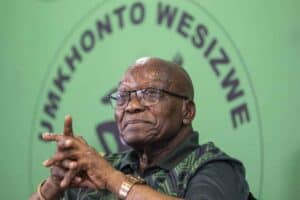This past weekend, the SAAF turned 100 years old, as the second-oldest formal air force in the world, after the Royal Air Force.

The “Caterpillar Club” lapel badge was worn by members of an informal, but perhaps the most exclusive, club in the world: pilots who had successfully used a parachute to escape a doomed aircraft.
The one my father had was not his, but was given to him by one of the pilots in the South African Air Force (SAAF) 2 Squadron, in recognition of the fact that the parachute which saved that pilot’s life had been packed by my father.
As a technician in the 2 Squadron ground crew in the Korean War in 1951, my father was in charge of safety equipment. And the parachutes were called into regular service. The SAAF pilots were flying American-made Mustang fighter bomber aircraft in ground attack roles and were vulnerable to ground fire.
Of the 95 Mustangs the SAAF deployed in Korea, 74 were lost. A total of 34 pilots were killed – and many more were repeatedly forced to bail out of stricken aircraft.
The first pilot to get shot down, bail out and make it back to base after being rescued by American search-and-rescue teams made a detour to the pub to pick up a crate of beer on his way to the safety equipment hut, where, on arrival he boomed at my father: “Right, Paddy! Now we drink!”
My father also packed the chute that saved the life of a 20-year-old Denis Earp, who went on to become chief of the SAAF in the ’80s. Earp was captured by the Chinese and spent three years, until the end of the war in 1953, in a prisoner-of-war camp.
The SAAF went to Korea as part of a United Nations force that eventually managed to stop the North Koreans and Chinese from seizing the whole of the country.
Even today, the South Korean government recognises the sacrifices of the SAAF personnel, maintaining a cemetery (which has a Springbok emblem) where some of the pilots are buried.
When my father was still alive, he and other Korean War veterans were sent a card each year by the government in Seoul, which thanked them for ensuring South Korea remained free.
Other SAAF pilots gave their lives in World War II in the fight against fascism. One of them was Charles Barry, who was flying the reconnaissance Mosquito which brought back the first photos of the Auschwitz death camp.
Barry was forever traumatised by his war experiences and tried to commit suicide twice. He was unsuccessful the first time and left with a limp from his injuries.
The second time he succeeded. He was retired but working for the then Argus company in The Star building in Joburg, compiling the regular newsletter. That’s where I came to know him, although I only found out about his wartime experiences later.
Barry threw himself to his death from the top floor of the building in the early ’90s. This past weekend, the SAAF turned 100 years old, as the second-oldest formal air force in the world, after the Royal Air Force.
I am glad that squadrons and all ranks found a way to celebrate that, despite attempts by the ANC government and its generals to rewrite history and pretend the SAAF never existed before 1994, because of its role in “supporting apartheid”.
There are many other stories of SAAF heroism and professionalism that should not be shot down by politics.
For more news your way, download The Citizen’s app for iOS and Android.






